Action Comics #1 (DC, $3.99)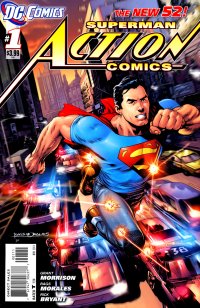
By Jeb D.
I can’t help it—I know I should be looking at this as though I were a reader with no prior knowledge of this “Superman” guy, but that costume is absolutely adorable: muscle T, cuffed pajama jeans, Doc Martens and a red picnic tablecloth. I mean, I get the whole “regular guy” aspect to the clothes, while the cape is every bit as nonsensical in any real world sense as it ever was. I’ll actually be sorry to see the new “classic” look when it happens (though I dig the Nehru collar that Jim Lee has given it– groovy, baby).
But I digress. Grant Morrison and Rags Morales relaunch Action Comics with a sequence of callbacks and shoutouts to the original (several panels and situations are taken straight out of early issues of Action). We have a Smallville-style Superman who is not quite yet fully super, a bit of a card (he even appropriates Rambo’s “your worst nightmare” line), and with a mean streak where bad guys are concerned. And, of course, no one loves the Golden Age more than Morrison, so the tale spun here, of Metropolis’ reaction to the mysterious “superman” that has emerged, is pretty good.
I know not everyone takes to Morales’ style (I find it odd that he gets criticized for being too “comic-booky”—it’s a damn comic book, folks), but I thought he was just right for this: plenty of energy, and he even manages to keep things moving under the weight of Morrison’s exposition, which takes place in a flood of word balloons (the folks in Metropolis are a talky bunch). He also has Clark muss his hair up when he wants to hide his identity, which strikes me as a bit of a retreat (since there’s no way Clark could actually hide his identity without use of mask or outright disguise, why even pretend he could?).
A fun comic, but there’s an oddity about the whole thing: really, Busiek’s JLA/Avengers wasn’t that long ago, and his demarcation of the differences between the two main comic book universes worked pretty well: the DCU was a place where superheroes were beloved and honored, while the Marvel U was a darker realm, where suspicion and dread often surrounded the doings of their superbeings. Based on what we see here—the paranoid scheming of Lex Luthor and General Lane, their fear of what this alien being might wreak on an unsuspecting earth (as well of his old-school moral code)—it’s as though DC has decided that what their readers have always wanted was to see their classic heroes in the Marvel Universe. In fact, strip away the specific homages to old issues of Action and this reads lot like a Spider-Man comic; I half expected to see Luthor post a sign saying “Superman: Threat or Menace?” Which isn’t that bad a direction, I guess, but it does tend to diminish Superman as the ur-superhero: the endless “What if” variations on the Man of Steel, in Astro City, The Authority, Supreme Power, etc., always shone reflected glory on the original, reaffirming his standing as the reference point for all that followed. If he’s no longer the exemplar, if he’s going to be just as screwed up as Green Arrow or whoever’s The Flash this week, he may wind up being more important as a trademark than as a character (see: Wonder Woman). But, hey—you can never deny the sales power of a new #1 issue. Or a bunch of them.
Rating: 




Out of a Possible 5 Stars
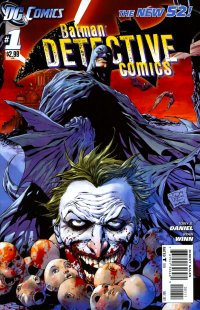 Detective Comics #1 (DC, $2.99)
Detective Comics #1 (DC, $2.99)
By Jeb D.
The “new” DCU status quo (its denizens appear to be a superstitious and cowardly lot) has pretty much been the operant in the Bat corner for some time now, and the other Golden Age legacy relaunch this week is right in step. The last time I read a few issues of ‘Tec, J.H. Williams III was offering some wonderfully phantasmagoric flights of fancy while folks like Greg Rucka and Paul Dini scripted some actual “detective” stories, but in this first issue of the new numbering, artist-writer Tony Daniel is pretty much running the standard post-Killing Joke/DKR playbook. In theory, it’s an early meeting of Batman and The Joker, but it plays out pretty much the way they usually do: The Joker is murderously insane, but with a cunning plan, Batman takes his lumps, doles out rough justice, letting The Joker live, even though his instincts tell him that The Joker will go on to kill again (which will, of course, free Bruce Wayne to wallow in the guilt to which he’s accustomed). The comic-film synergy is solid, with Gordon and Bullock locking in place, and the art is kinetic and bloodthirsty. As a “debut” issue of a new comic, I don’t know that it would exactly bowl me over, and if you’ve ever read a Batman comic before, you’ve read this one. But if you’re a fan of the Caped Crusader, here’s the first chapter of his latest adventure.
Rating: 




Out of a Possible 5 Stars
Men of War #1 (DC Comics, $3.99)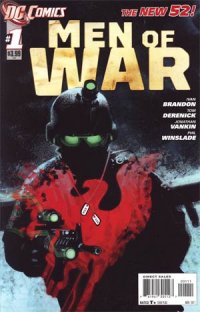
by Graig Kent
Military and war stories aren’t my bailiwick. Growing up it always seemed to me that the fascination with the minutiae of war and the militia was part of my grandparents’ generation, with one grandfather having an intriguing collection of items from his service days and a well-stocked library of fiction and non-fiction war novels, the other a sizable collection of war movies on videocassette. I know that it’s not only “the greatest generation” that is into this stuff, as it seems that servicemen in general over the years have had a particular attraction to this type of storytelling. Is it because it’s all they understand, or is it that they’re still struggling to try and understand… I’m so not capable of psychoanalyzing this.
DC Comics has published many different genres of stories under their masthead over the past 80-or-so years. Although superheroes have been their primary genre throughout, they’ve had extensive dalliances with fantasy, sci-fi, horror, supernatural and even romance. None have quite sustained like their superheroes, although their war comics were quite prominent from the fifties on through to the early 1980’s and have barely been seen since. I have to wonder if it has to do with the wars that the “western world” has been involved in in the intervening years (Korea, Vietnam, Iraq x2, Afghanistan), less glorious than the World Wars, less ideological even. The general feeling towards the military seems to be more sympathetic of the individuals than supportive of the operational whole. Unlike war stories told in the 50’s through 80’s (still largely based in WWII) where the tales seemed to be as much, or more so, about the military maneuvers as the people involved in it, war stories of recent years seem to be more about an individual’s journey through war (although they’re just as often dealing with the individual’s journey post-war).
Men of War was one of DC’s shorter-lived war series, lasting 26 issues in the late 1970’s centering around a soldier named Gravedigger. In “The New 52” revival, Men of War is a vehicle for distinguished Corporal Joe Rock, grandson of war legend Frank Rock, recruited from general service into an elite special missions squad, which in this first issue crosses paths with a superhero/villain tussle in a heavily contested region. It’s not quite the pure military combat/action/adventure story that DC used to produce, but at the same time writer Ivan Brandon handles this first issue with a lot of military swagger and the right smattering of jargon (though, thankfully, not an overwhelming abundance) to give a grunt’s-eye-view of the imposition of the superhuman on their mission. There’s a lot of top-heavy talking that gives way to some dizzying action, artist Tom Derenick handling both with equal aplomb. Colorist Matt Wilson is the secret weapon here, his use of color, or lack thereof, for the flashback sequencing is terrific and his muted, washed-out palette matches Derenick’s work well, giving it a Ridley Scott-esque level of cinematic grit. Derenick’s figure work can be a little stiff at times, but I’m think it’s more a conscious decision based on the heft of the gear and attire the soldiers are saddled with than it is a limitation of his style.
Brandon for his part keeps the action at ground level, and the presence of the superhumans is wonderfully abstract. Derenick provides some shadows and blurs for the super-powered figures but otherwise they’re unidentifiable and never in direct contact with or part of the sphere of influence of the book’s characters. It’s actually a really sharp way to handle that aspect of the world, making it feel truly like a war book in a superhero landscape. In this respect, like many of DC’s war stories of old, it tells the story of men in action as they face elements of battle that are beyond belief. It’s a classic feel with a modern twist.
But surprisingly enough, Men of War doesn’t end there, as Jonathan Vankin and Phil Winslade provide an even more straight-up military back-up feature in “Navy SEALs: Human Shield”, the first of three parts. It’s a modern version of an on-the-battlefield story, taking place in an undisclosed location as the SEALs are in mid-operation and come under sniper fire. It’s a fairly rote set-up, decently told and well illustrated, that leads to the cliffhanger ending from which the story gets it title, so there may be some change-ups in store yet.
The back-up element was unsolicited, though looking back I see that the book was indeed listed at $3.99 and 40 pages (though it is only 28 pages of story). DC attempted back-up features in multiple books a couple years back as a value-added option to raising the price point to $3.99, but the venture lasted less than a year and they rebounded with a “Holding the line at $2.99” campaign for all titles. I’m skeptical that this one-off in “The New 52” will fare any better. Much speculation has already gone on, even before the release of any of “The New 52”, about which won’t make it past the first year. While I’m certain there’s an audience for war comics, and I think that Men of War from my limited frame of reference, actually fits the bill quite nicely, it feels that by saddling it with a back-up feature (regardless of quality) and the higher price point that it’s been earmarked to fail from the onset.
Rating: 




Out of a Possible 5 Stars
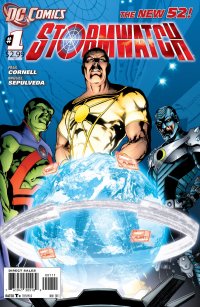 Stormwatch #1 (DC Comics, $2.99)
Stormwatch #1 (DC Comics, $2.99)
By Devon Sanders
Stormwatch, the book that directly and indirectly launched the careers of comics superstars Warren Ellis, Bryan Hitch, Mark Millar and Frank Quitely is back and thankfully, as forward thinking as ever. Writer Paul Cornell, one of comics’ smarter writers, crafts a tale very much set in the DC Universe present. The Martian Manhunter, following a philosophical fallout with The Justice League, has gone on to join something different. Stormwatch, a group with roots dating to and possibly before The Age Of Enlightenment. Stormwatch mainstays The Engineer, Jack Hawsmoor and Jennie Quantum along with new and fascinating members, including a possible immortal. Two, though, are not in place. Apollo, a man with Superman power levels refuses to join and soon, with one handshake from one very familiar with fans of The Authority, a new World’s Finest is born. Cornell’s writing is full of allusion and possibilities and a true bit of fun for fans of the former Wildstorm brand and as a true, diehard DC fan, Cornell gave me plenty to look forward to with Stormwatch #1. Artist Miguel Sepulveda’s art with it’s mixture of ink and digital is fluid while perfectly capturing the sense of dark menace writer Cornell aims for. Stormwatch #1 is a brilliant comic exploration of the scope and depth of DC “new” universe. Definitely one you’ll want to pick up.
Rating: 




Out of a Possible 5 Stars
Static Shock #1 (DC Comics, $2.99)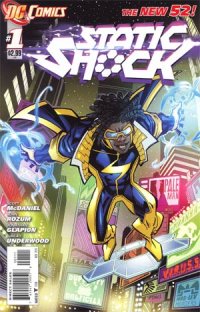
by Graig Kent
Static was the breakout character of the Milestone line that debuted in the mid-1990’s, as an extremely intelligent high-school kid suddenly imbued with super-powers whose wisecracking was just a much a part of his arsenal in fighting crime, the Spider-Man comparisons were natural, obvious even. Except, you know, Static is black and Spider-Man isn’t… well, he wasn’t then anyway. After the Milestone line shuttered up, Static lived on in a highly successful cartoon series with peripheral ties to the Justice League animated series, and the rumors were fairly constant that Static, of all the Milestone breed, would be integrated into the DCU proper, most likely as a member of the Teen Titans. A few years back it finally happened, when DC went on a rights acquisition spree (solidifying the rights to the Milestone characters, the Archie/Red Circle heroes, and the T.H.U.N.D.E.R. Agents) and Static finally made his way into the DCU proper… via the Teen Titans. Unfortunately he was seriously mishandled and his return was less than electrifying.
But he’s back, and a key part to “The New 52”, well, as key a part as one can play when they’re just one of 52 new books. Static hasn’t had a regular series since 1997, so Virgil Hawkins is ripe for reintroduction, if not redefinition. Here, thankfully, his history isn’t so much as dispensed with as side-stepped, transferred from Dakota to New York (though Dakota is definitely not forgotten), there’s never a better setting to further the Spider-Man parallel while also differentiating the character and reestablishing what makes him unique.
Unfortunately, the first issue doesn’t do the greatest job in establishing Virgil’s new status quo. Oh sure, all the elements are present — Static’s new costume, his new secret hideout, his new job at S.T.A.R. Labs, his high school life, his home life, his long-distance apprenticeship under Hardware, not to mention some bad guy fighting — but it’s all handled rather bluntly and inorganically. Some of these facets could have waited a few issues to get a proper introduction. As is, it’s disjointed, less a story and more a series of vignettes which may have been okay had it been framed as “a day in the life of Virgil Hawkins”.
That said, what is set up here, for any old Static fan, has a feel of familiarity. Co-writers John Rozum and Scott McDaniel seemed to brush up on the original series to get a handle on Virgil, although through this first issue there’s still not a lot to distinguish him from your average teen hero yet. Static seems well established as a hero, yet still somewhat green, more so in his new surroundings. One of the subtle comments that Rozum and McDaniel make, which seems reflected throughout other “New 52” titles I’ve read (like Justice League or Action Comics) is the people and police don’t seem to be all that enthused by the presence of superheroes, so there’s a sense of that many heroes will need to make a concerted effort to “win the people over”, so to speak (perhaps a metaphor for the readership as well?). Hopefully Rozum and McDaniel are able to better juggle Static’s many facets and provide a deep supporting cast. There’s a lot of potential here and plenty of room to win the reader over.
McDaniel handles the penciling on the series as well, with Jonathan Glapion and LeBeau Underwood on inks. McDaniel is very capable of dynamic sequencing, his work many years back on Nightwing is still fondly recalled. However McDaniel used shadows a lot in the past to mask his weaknesses, like the looseness of his lines and unrefined details, which here are quite exposed and occasionally problematic in understanding the visual storytelling, and consistency of his characters is also an issue. But there is the hint of his old dynamics at play, and hopefully he cuts loose in further issues, perhaps even defining a distinct visual effect, Kirby-style, for Static when using his powers.
Although he’s not in top form, I’m still glad to see Static back on the shelf.
Rating: 




Out of a Possible 5 Stars
B
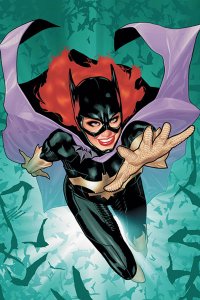 atgirl #1 (DC, $2.99)
atgirl #1 (DC, $2.99)Swamp Thing #1 (DC, $2.99)
By Adam Prosser
When comics readers, writers, editors, and hangers-on discuss the problem of the dwindling audience, it’s always taken for granted that the big obstacle to new readers is intricate continuity. This is, presumably, the main idea behind the “New 52” reboot, to get a lot of press and to rope new readers who may be looking for a new jumping-on point. In theory, this is sound, but in typical fashion, superhero comics have found a way to shoot themselves in the foot, by making reboots every bit as complicated and inaccessible as the continuity they’re supposedly supplanting. Just look at Crisis on Infinite Earths. To someone not heavily steeped in the DC universe, it’s borderline incomprehensible, and for long stretches it’s more of a checklist than a story. Now, granted, “Crisis” was specifically meant to celebrate the history of DC for the hardcore fans before it rebooted, but to me it’s become emblematic of the way the Big Two, DC in particular, go about “streamlining” their continuity. If you really want to reach new readers with a less complex continuity, you simply…present a less complex continuity. You don’t justify it with a multi-part crossover epic that reveals Power Girl to be from Atlantis or whatever; you just rewrite the backstory and then drop it.
I’m not necessarily condemning these elaborate, self-justifying shenanigans; superhero comics have to appeal to their existing audience, and callbacks to pre-existing storylines and plot elements are a way to do that. But you can’t have your cake and eat it too. Either your book is aimed at new readers, or it’s aimed at longtime fans. If you try to have it both ways, you get something that doesn’t really appeal to either group (which I think is where last week’s Justice League #1 fell) or you end up with a rather pointless change to the status quo that won’t make sense to anyone who isn’t familiar with the previous version of the characters. The ironic result: continuity purges aimed at continuity fans.
These two books, regardless of their flaws and virtues, illustrate this tendency quite well. Here we have two #1 issues—supposed fresh starts—that are completely overshadowed by what’s come before. As it happens, in both cases, said shadow is cast by Alan Moore, with The Killing Joke and The Anatomy Lesson, respectively, informing the events of the stories. And in both cases, the writers are making an odd attempt to write around the epochal events of Moore’s writings, in what seems almost like an act of spite for his disparaging comments of late.
Over in Batgirl, as we’ve seen, one of the more controversial decisions of the reboot has been made, granting Barbara Gordon the use of her legs and taking her from the paralyzed computer hacker Oracle back to her original role as Batgirl. And make no mistake, she has been explicitly granted the use of her legs again—the events of The Killing Joke are referenced, along with her paralysis. Some unknown event has cured her. Except that a new baddie is out there, seemingly taking his cues from Final Destination, and offing people who have walked away from tragedies. And it looks like Barbara’s on his list.
Like a lot of people, when I first heard that Barbara was getting back into the Batgirl costume, I was slightly appalled. Whatever the circumstances of her creation, Oracle had become a memorable character, and more importantly, a visible, positive role model in the DC Universe for people with disabilities. I happen to think this spirit of inclusion is very important in superhero comics; it’s not about “Political Correctness”, but simply portraying the world as it is, and doing what superheroes are supposed to do: inspire people. Seeing a superhero in a wheelchair can make an honest to God difference to some young fans—if the genre is going to claim that it has relevance beyond being simple power fantasies, then providing inspiring role models seems like the obvious place to start.
Having read the issue, I’m still highly dubious of this decision (which also apparently “demotes” a couple of perfectly good Batgirls who were already out there), but I am prepared to give writer Gail Simone a chance. Ironically, the first issue I raised, the needless invocation of continuity into what’s supposed to be a clean slate, helps deal with the second one. Simone’s not simply rolling back the clock, to her credit; whatever story she’s trying to tell here, it’s going to take Barbara’s paralysis and her role as Oracle into account. The problem is that this doesn’t seem to be going anywhere tremendously new and exciting so far, and it even strays into goofy territory in its attempts to evoke the hard-boiled style we associate with the Bat-books. This comic doesn’t have to be a big step backwards, but it’s making a pretty halfhearted case for itself so far.
Over in Swamp Thing, we get something I honestly can’t say I was expecting: the saga of Alec Holland, construction 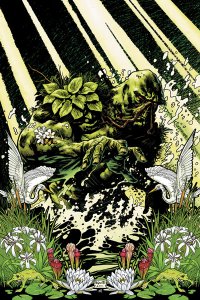 worker. Here there’s even less of a pretense that the story isn’t following on previous events, though ironically I could see a new reader following this fairly easily, as Alec exposits heavily about his dreams of being turned into a human vegetable and plant god. Obviously, in the DCnU, Alec is neither dead nor a vegetable, and in fact it’s rather strange to see him again, since Alec Holland had been marginalized in the Swamp Thing mythology ever since Moore took over. In fact, Swamp Thing is the one who’s marginalized here, appearing only at the very end of the book. Up until then, we’re watching ominous events beginning to unfold, as bird and other animal populations suddenly expire around the world (to the consternation of the Justice League members), fossils mysteriously start to come to life, and some creepy offscreen force starts twisting people’s heads around on their bodies and then enslaving them as shambling horrors (a nod to the Invuche, another reference to Alan Moore’s run).
worker. Here there’s even less of a pretense that the story isn’t following on previous events, though ironically I could see a new reader following this fairly easily, as Alec exposits heavily about his dreams of being turned into a human vegetable and plant god. Obviously, in the DCnU, Alec is neither dead nor a vegetable, and in fact it’s rather strange to see him again, since Alec Holland had been marginalized in the Swamp Thing mythology ever since Moore took over. In fact, Swamp Thing is the one who’s marginalized here, appearing only at the very end of the book. Up until then, we’re watching ominous events beginning to unfold, as bird and other animal populations suddenly expire around the world (to the consternation of the Justice League members), fossils mysteriously start to come to life, and some creepy offscreen force starts twisting people’s heads around on their bodies and then enslaving them as shambling horrors (a nod to the Invuche, another reference to Alan Moore’s run).
This is all compelling, and it’s certainly going to pique the interest of any longtime Swamp Thing fan, since the scenario writer Scott Snyder has envisioned here is so far off the usual status quo of this book. But it suffers from many of the same decompression problems that the Justice League book of last week did. Swamp Thing has always been a “modular” book, in which the main character could potentially remain offstage for an issue, but that’s traditionally been for the purpose of telling someone else’s story. Here, it’s all vague intimations and foreshadowing and Superman cameos; the actual plot of this issue is extremely thin. I’ve really enjoyed Snyder’s work over on American Vampire, and he does a great job with the horrific here; the book shows a lot of promise, but first it’s got to stop meandering and hook us with a real premise, fast.
To look at these two books, it seems like the idea that continuity was going to be reset in the DCnU was wildly overstated. These books are aimed at the same readers as before, and seem to be using the same old tricks as well. While there’s potential here for fans of these characters, the renumbering has revealed itself as a dumb gimmick, and these don’t offer any more of a jumping-on point than the usual arrival of a new writer. While it’s nice to know that DC isn’t going to throw the baby out with the bathwater, these smaller books more or less clinch it: the New 52 isn’t a radical new direction; it’s just another marketing gimmick.
BATIGRL:
Rating: 




Out of a Possible 5 Stars
SWAMP THING:
Rating: 




Out of a Possible 5 Stars
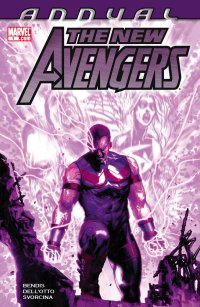 New Avengers Annual #1 (Marvel, $4.99)
New Avengers Annual #1 (Marvel, $4.99)
By Jeb D.
I’m sure you’ve long suspected that the principal reason for superhero comic “Annuals” is to separate you from a few extra bucks… and you’re probably right. But they can serve other functions, and one of them is to allow artists who can’t keep up with an ongoing schedule to strut their stuff. In this issue (which I guess is, technically, the first New Avengers Annual of 2011, since we also had a New Avengers Annual #1 last year), writer Brian Bendis reteams with his Secret War partner Gabrielle Dell’Otto, along with colorist Ive Svorcina, and the result is the most giddily entertaining superhero slugfest of the year.
Wonder Man is pissed at the current crop of Avengers; wrongly, perhaps, but he’s nuts so it doesn’t matter. What does matter is that he recruits a crop of “Revengers,” with C-list toughs like Atlas, Devil-Slayer, Anti-Venom and D-Man (so maybe I meant “D-list”) to take on Luke Cage and company, whereupon Bendis mostly stands back and lets Dell’Otto go to work with page after page of glorious mayhem, tossing in the odd wisecrack here and there to keep things in character. In the end, we get a cliffhanger leading right into the upcoming Avengers Annual #1 (what was that I said about separating you from a few extra bucks…?).
My only real reservation with the comic is editorial: the Revengers include several characters that the New Avengers ought to know better than they seem to (they don’t even seem fazed that there’s a new Goliath, in the person of the late Bill Foster’s son); Bendis ought to have caught that and tossed in a reference or two, but it’s an editor’s job to make sure it happens.
If you’re not happy with Simon Williams as the latest Marvel hero to go from villain to hero to villain again, you’ll want to skip this while cussing out Bendis; if you’re just pissed that you’re only getting the first half of the story, you’ll want to skip this while cussing out Buckley or Brevoort. But if you want to see Dell’Otto wreak gorgeous, gleeful havoc on spandex characters, it’s the book for you.
Rating: 




Out of a Possible 5 Stars
Atomic Robo and the Ghost of Station X #1 of 5 (Red 5, $3.50)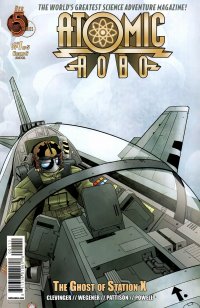
By Jeb D.
By now, the Atomic Robo franchise is sufficiently well established that we can get a sense of continuity, with its own little “universe” being created: this issue has callbacks to previous series (including the reappearance of the Action Scientists, and the son of Robo’s wartime compatriot, Sparrow), but that shouldn’t scare off new readers: these details help to add depth and texture, but don’t in any way interfere with new readers jumping on (and it’s statistically probable that that includes you).
Our metallic hero is the creation of Nikola Tesla, and like Hellboy, he’s attached to a group called Tesladyne Industries, a sort of “Fringe Division,” tasked with investigating the weird and paranormal. In previous series, Atomic Robo has fought in World War II, flown to Mars, and battled Lovecraftian monsters. In this issue, Tesladyne is faced with mounting a rescue mission for astronauts on a crippled space station, and they only have seven hours to do it. It’s rather a talky issue, but writer Brian Clevinger makes the dialog count, as the team’s plans and preparations against the ticking clock have the kind of buzz that this sort of “bright people thinking on their feet” storyline can bring (think Apollo 13), while the plausible-but-out-there science, and the clean and colorful art from Scott Wegener, make it a joy to follow; the lovely final pages of the mission into space itself (and the cliffhanger aftermath leading into the rest of the series) are almost a bonus.
The sales charts would suggest that most of you out there aren’t reading Atomic Robo yet, and I’m disappointed: get on it, folks. Like Hellboy or Invincible, it’s the kind of pure comic-book fun that I know a lot of you don’t feel that you’re getting from the Big 2 these days.
Rating: 




Out of a Possible 5 Stars
Mystic #1-2 (CrossGen/Marvel, $2.99)
By Adam Prosser
The receive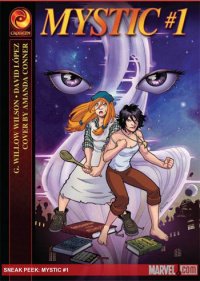 d wisdom seems to be that the nerdiest, most inaccessible genre out there is fantasy. Even SF has gone fairly mainstream at this point, but fantasy only occasional ly produces a hit on the level of Lord of the Rings or Harry Potter. Part of the reason for this seems to be the elaborate, “sub-created” worlds (to use Tolkien’s phrase) that differ so wildly from our own, and which require a certain…effort of imagination, as well as suspension of belief, on the part of the reader. While am original, distinctive universe can be a big part of what’s compelling about the genre, a lot of fantasy writers tend to disappear up their own backsides when it comes to setting up their stories, often spending so much time world-building that they seem to forget all but the most rudimentary aspects of character and plot. The result is often like reading an encyclopedia about a world that never existed, with a light varnish of Joseph Campbell clichés to make it technically qualify as a narrative.
d wisdom seems to be that the nerdiest, most inaccessible genre out there is fantasy. Even SF has gone fairly mainstream at this point, but fantasy only occasional ly produces a hit on the level of Lord of the Rings or Harry Potter. Part of the reason for this seems to be the elaborate, “sub-created” worlds (to use Tolkien’s phrase) that differ so wildly from our own, and which require a certain…effort of imagination, as well as suspension of belief, on the part of the reader. While am original, distinctive universe can be a big part of what’s compelling about the genre, a lot of fantasy writers tend to disappear up their own backsides when it comes to setting up their stories, often spending so much time world-building that they seem to forget all but the most rudimentary aspects of character and plot. The result is often like reading an encyclopedia about a world that never existed, with a light varnish of Joseph Campbell clichés to make it technically qualify as a narrative.
Even when the writer dodges this trap and remembers to tell a story, there’s that inaccessibility problem again: how do you relate to a character who lives in a world of magic and monsters? This may actually be part of why fantasy characters can be so generic: at least then the author can count on us project ourselves onto them.
G. Willow Wilson, with her revival of CrossGen’s Mystic, has taken the harder road to relatability. While her lead characters have a whiff of the Hero’s Journey about them, in just two issues both they, and the story in which they’ve become entwined, have developed a satisfying specificity. And more importantly, Wilson’s found a way to create an enchanting world while still making it seem relevant—even politically charged.
The leads are a pair of orphan girls, Giselle and Genevieve, living on the magical, steampunk-ish world of Hyperion. Here, technology is powered by magic—referred to as “the Noble Arts”—relying on the rare element of Aether, which can only be harvested twice a decade, and practiced only by the upper classes. Those born into poverty, like the two girls, are condemned to a life of servitude. But G & G refuse to let that stop them, and have been sneaking out at night to study magic. This pays off when the two manage to sneak into a wizard’s school and the cynical Giselle solves a magical poser to become the old master’s newest apprentice…leaving the embittered Genevieve in the dust. As Giselle is inducted into the catty ranks of magic school, Genevieve ends up falling in with a group of lower-class rebels, determined to overthrow the existing order and restore some kind of equality.
As well as the obvious class warfare theme which Wilson sets up elegantly (though perhaps a bit too abruptly), the second issue raises the question of whether an environmental disaster might have made it impossible to harvest Aether, leading to issues of resource depletion and technological stagnation. As you can see, then, this fantasy story is isn’t interested in helping the reader escape from real world issues! But it’s nevertheless rendered with buckets of charm, thanks in large part to the wonderful, cartoony art of David and Alvaro Lopez.
The CrossGen revival has been a little underwhelming so far; the original books leaned heavily on the nerdy world-building I mentioned above, and the relaunches’ attitude has been to simplify everything to the point where it seems dumbed-down and generic. “Mystic”, in contrast, strikes exactly the right balance, taking pride in its genre while staying accessible and fun. A real diamond in the rough, and one I recommend even to people who don’t know a half-orc from a halberk.
Rating: 




Out of a Possible 5 Stars
The Punisher #3 (Marvel, $299)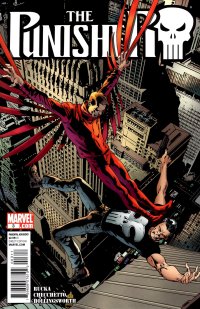
By Jeb D.
I’ve sort of run out of time this week, and can’t really do a complete review of this book, but I have to give a quick tip of the hat to Greg Rucka, Marco Chechetto, and Matt Hollingsworth for demonstrating that there is more than one way to integrate Frank Castle into Marvel’s superhero universe: while I enjoyed a lot of Rick Remender’s over-the-top run, in this issue, The Punisher meets, of all people, the new Vulture, and the often-airborne story is spectacularly dark, dangerous, and gloriously kinetic. The plot manages to complicate Frank’s life with an unexpected character reappearance, while always feeling wholly true to the more grounded (so to speak) version of the character that Rucka is shaping. Good stuff.
Rating: 




Out of a Possible 5 Stars